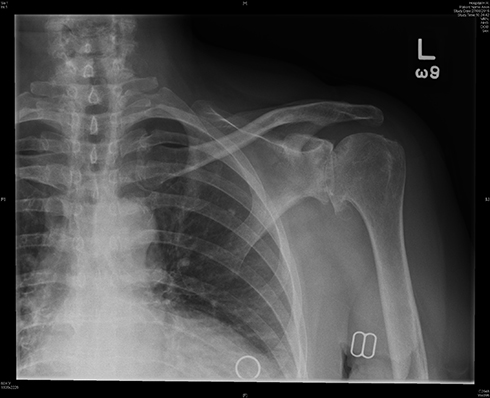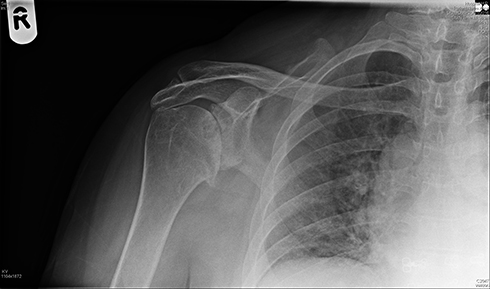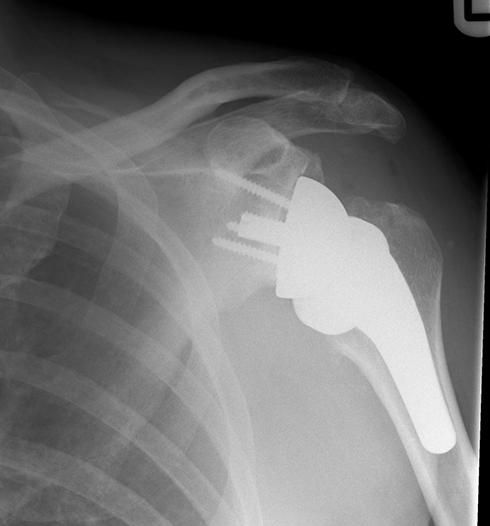What is shoulder arthritis?
Arthritis of the shoulder most commonly refers to osteoarthritis, or “wear & tear” arthritis. This is often a gradual process in which the normal cartilage covering on the ball (humeral head) and socket (glenoid) of the shoulder joint is worn away. This can lead to uncovering of the underlying bone and a stiff, painful, shoulder joint. Less common forms of arthritis affecting the shoulder may be due to inflammation, i.e. rheumatoid arthritis, or secondary to a long-standing massive rotator cuff tendon tear.What are the signs and symptoms?
Although less common than in the hip or knee, arthritis of the shoulder can be equally debilitating. Commonly it causes a constant deep-seated aching discomfort around the front and back of armpit that is exacerbated by movements of the shoulder and often disturbs any attempts to sleep. Significant restriction of movement of the shoulder is usually also seen; making previously simple day-to-day tasks such as washing one’s hair difficult or impossible.
Simpliciti preop
How is shoulder arthritis diagnosed?
The diagnosis of shoulder arthritis will usually be made based on a “narrowed joint space” on two X-ray views, in conjunction with the clinical history and examination findings. Sometimes a CT scan will be recommended to determine the bone present of the socket side of the joint to aid pre-operative planning by the surgeon. An MRI or ultrasound scan may be obtained to provide an accurate assessment of the integrity of the rotator cuff tendons within the shoulder to determine the most appropriate design of shoulder replacement to use.How is it treated?
- Non-surgical Oral pain relief medication, in combination with modification of daily activities, may help to alleviate some of the symptoms of shoulder arthritis. A local anaesthetic and corticosteroid injection into the shoulder joint may settle some of the inflammation secondary to the arthritis, and provide some temporary pain relief. In patients with early arthritis, an alternative injection of hyaluronic acid, e.g. synvisc, may be recommended.
- Surgical
If the above measures fail to provide an acceptable level of improvement in symptoms then surgical intervention can be considered. In younger patients with evidence of earlier degenerative changes within the shoulder joint, a key-hole operation to washout the joint, remove any excess bone that may have formed (osteophytes) and release the tight capsule of the shoulder can provide good pain relief.
In more established cases of shoulder arthritis, we will most likely recommend a total shoulder replacement. This procedure involves removing the worn out socket and ball bearing surfaces from the shoulder joint and replacing them with synthetic ones. If at all possible we would aim to replace both the socket and ball side of the joint to maximise the pain relief obtained from the procedure. Very occasionally it may not be technically possible to implant an artificial bearing surface on the socket side of the joint; in which case the ball bearing surface alone will be replaced. This is known as a hemi-arthroplasty.
Two types of total shoulder replacement are available: “anatomic” and “reverse”. The condition of the rotator cuff tendons within the shoulder determine which of these two types of shoulder replacement will be most appropriate – an equal degree of pain relief can be expected from both. In an anatomic replacement, a plastic socket is cemented in place and a metal ball fixed to the arm bone (humerus), often without the need for cement, using either a “stemless” or “short stem” design. Research shows that if the rotator cuff tendons are not functioning normally, an anatomic replacement plastic socket will tend to show signs of loosening at an earlier-than-acceptable time point following surgery (less than five years). To avoid this scenario occurring, a reverse replacement would be recommended for shoulder arthritis and non-functional rotator cuff tendons. As the name suggests, in a “reverse” total shoulder replacement a metal hemi-sphere is implanted on the socket side of the shoulder joint and a plastic “socket” within a metal stem on the arm bone (humerus) side. This design arrangement of the new prosthetic shoulder joint is able to compensate for the lack of rotator cuff function by recruiting the large deltoid muscle to take on their work; thus avoiding the problem of any early component loosening.
What are the potential complications?
Any surgical procedure carries with it some potential risks and we will help you to weigh these against the proposed benefits pre-operatively so you feel able to make a fully informed decision about your care. The risks associated with a general anaesthetic are usually low and will be discussed during your pre-operative assessment, the surgical procedure carries with it a risk of bleeding (very rare to require a blood transfusion), infection, damage to nerves / tendons / blood vessels, stiffness, fracture, dislocation and long term wear and loosening of the components. These latter complications would usually only occur 10-15 years following surgery and the need for any potential revision surgery can be anticipated as part of routine out-patient surveillance of your new shoulder replacement.What rehabilitation is necessary after surgery?
Shoulder replacement surgery is performed under general anaesthetic with a regional anaesthetic block used to provide excellent post-operative pain relief. The patient will usually be admitted to hospital on the day of surgery and often only need to stay for one to two nights following the operation. A sling will be provided for use in the initial four to six weeks following surgery and physiotherapy advice, and future outpatient appointments, will be provided prior to discharge. Most patients find the relief of the arthritis pain to be immediate but it commonly takes three to six months for patients to return to daily activities without restriction. Expect to be unable to drive for a minimum of eight weeks. There will be regular follow-ups in the outpatient clinic following surgery with check X-rays as appropriate.
Simplicit post-op

Pre-op ascend flex TSA

post-op ascend flex TSA

Ascend flex reverse
Testimonials
A big thank you to Simon and his team for their care, patience and perseverence looking after me through all stages of both shoulder and elbow surgery.
Since the shoulder stabilisation I have continued my sailing and fitness training without the worry that my shoulder might dislocate; and I don’t have to think twice whether my ulnar nerve will hinder any progression in my sports.
With their amazing help, I’ve been able to get back to sailing competatively and am now a double National champion.
After multiple shoulder dislocations Charlie helped me set a route for recovery, which has been nothing but smooth sailing. Surgery went successfully and I am well on my way to playing the sports I was previously. Would highly recommend.
Simon successfully operated on my frozen left shoulder in 2012 with fantastic results. This year he has overseen and advised treatment for my frozen right shoulder (via hydrodilation injection). His unrivalled experience in orthopaedic shoulder treatments, coupled with his reassuring bedside manner and excellent results, gave me huge confidence throughout. I’m hugely grateful to have my quality of life back and wouldn’t hesitate to recommend his services. Thank you Simon.
I had suffered with a painful shoulder and pins and needles for three years following a right shoulder fracture and failed half joint replacement prior to meeting Mr Pennington. He explained the situation in a way I could relate to and I’m delighted to say my revision shoulder replacement has gone well and for the first time in years I can use my arm and am pain free. I was even able to walk my daughter down the aisle 3 months after surgery! Many thanks.
I would like to thank Charlie Talbot and his team for the operations performed on both my shoulders and also the aftercare put in place after my operations. I have played golf since I was 12 years of age and thought at one point that I would never get back to playing again. Charlie was always very positive and told me that he would get me playing golf again. Well, I have now been playing golf for nearly 2 years. Before surgery I had a handicap of 12 and I am now down to 9, not bad at the age of 68. So many many thanks.
I had PRP injections into my right elbow last year and within 3 months I was pain free, a year on it is more or less 100% better. Fabulous I would recommend it to anyone with Tennis Elbow, in fact I have gone back again this year to get my left elbow done. Thanks Simon.
Mr Pennington I really wanted you to know how very thankful I am for the excellent care & treatment you and your staff gave me. It really meant a lot that you were so clear, friendly & professional and listened to me – so thank you again.
After more than four decades of shoulder problems with a total of three surgeries the full shoulder replacement surgery by Mr. Talbot has changed my life beyond expectations. I am now able bodied for the first time in years and pain free.
Thank you to Mr Boyle and team for the excellent care and attention both before and after Replacement Shoulder surgery, using the Tornier Simpliciti procedure. After very many months of severe pain and lack of movement I was pain free from day one. Now, after nine weeks, the shoulder and arm movement continues to improve, beyond expectation, with physiotherapy and exercise. I am extremely grateful for all the continuing care.
Following two years of recurrent problems with my left shoulder I was recommendedto Consult Mr Neil Pennington. I had the opportunity to have my surgery quickly and at my convenience, this fitted well around my professional and home commitments. The surgery was carried out as a day case procedure and Mr Pennington visited me following the surgery to explain everything. My operation was a minimally invasive procedure so my recovery was straightforward with only a few restrictions; in fact I was encouraged to keep my shoulder moving. I was driving and back to work after 2 weeks – after 2 years of pain and sleep disturbance I found this operation to be life changing! I found Mr Pennington to be a very professional and compassionate surgeon and he is surrounded by a whole team of professionals that gave me the utmost confidence in the care and treatment I received.
I would like to thank Mr. Talbot and the amazing team of nurses, physiotherapists and support staff for their care and support during my recent visit to the Duchy Hospital, Harrogate, for a replacement shoulder. The care and attention I received was unparalleled. The pain free movement I now have has changed my life.


